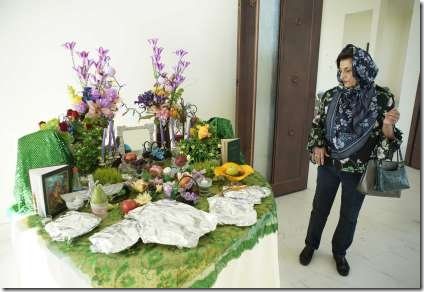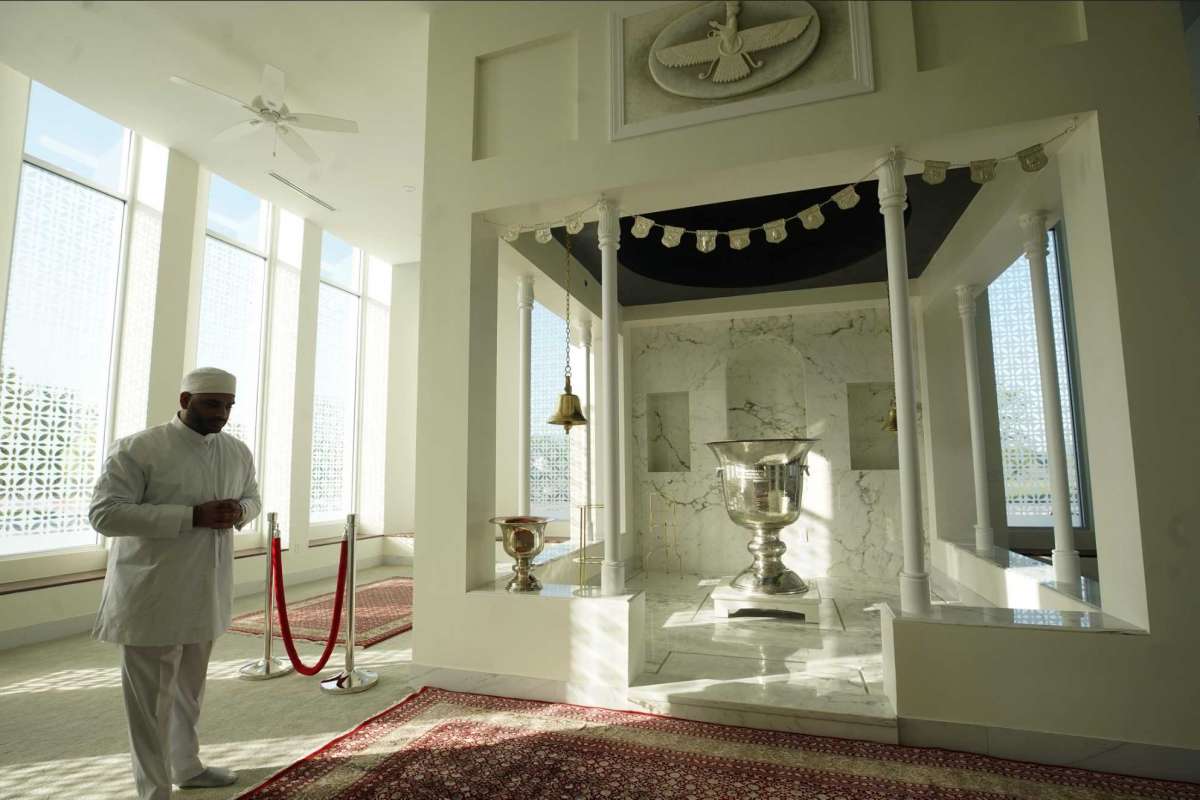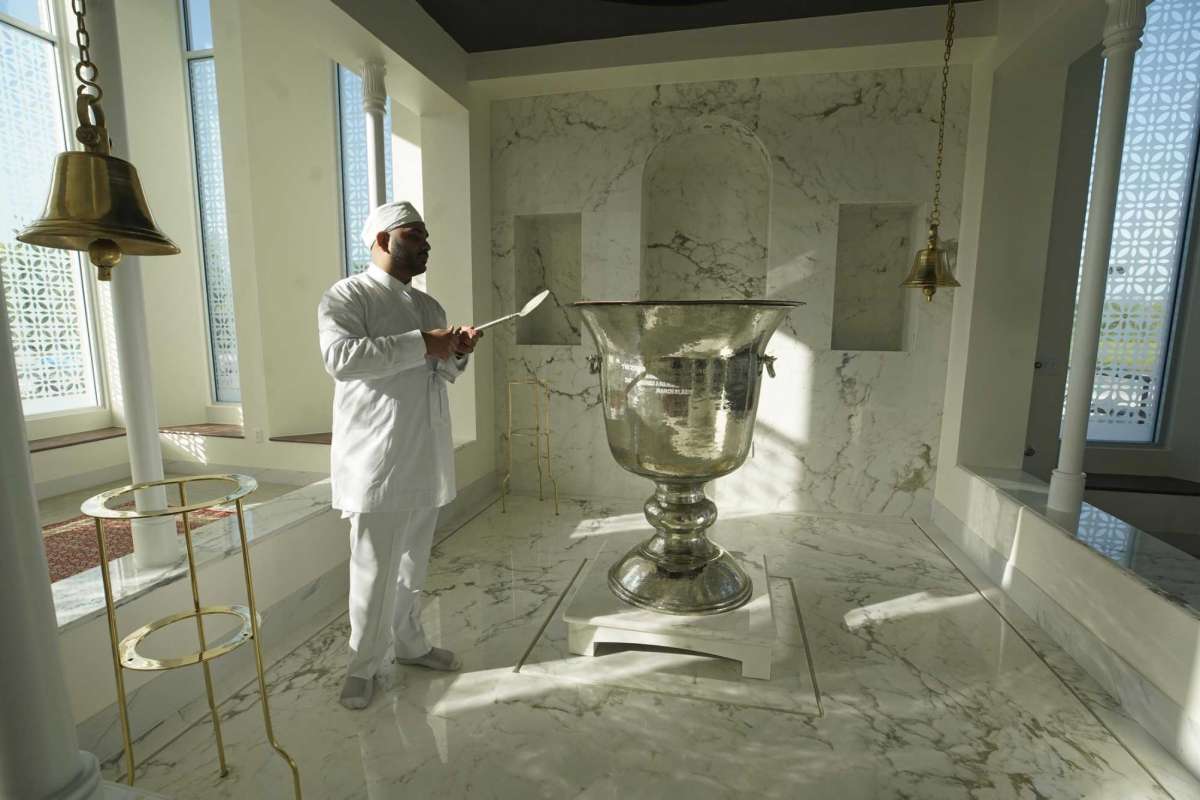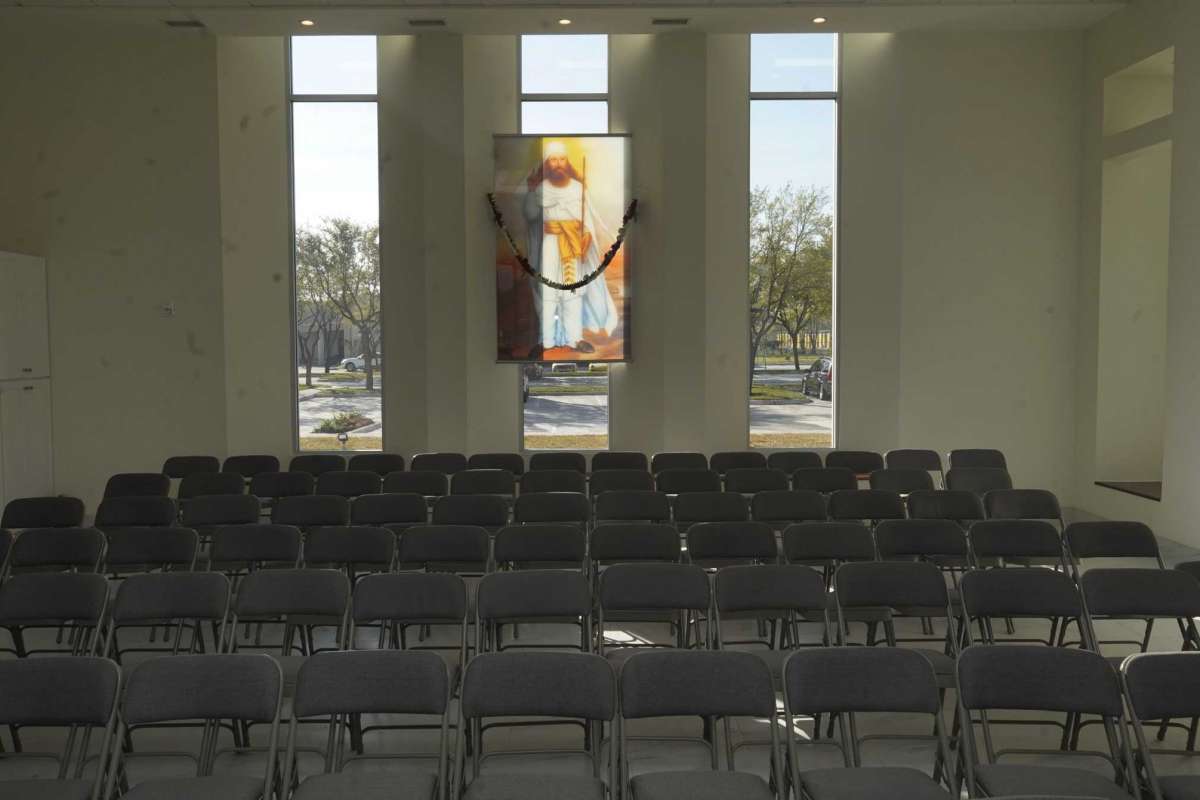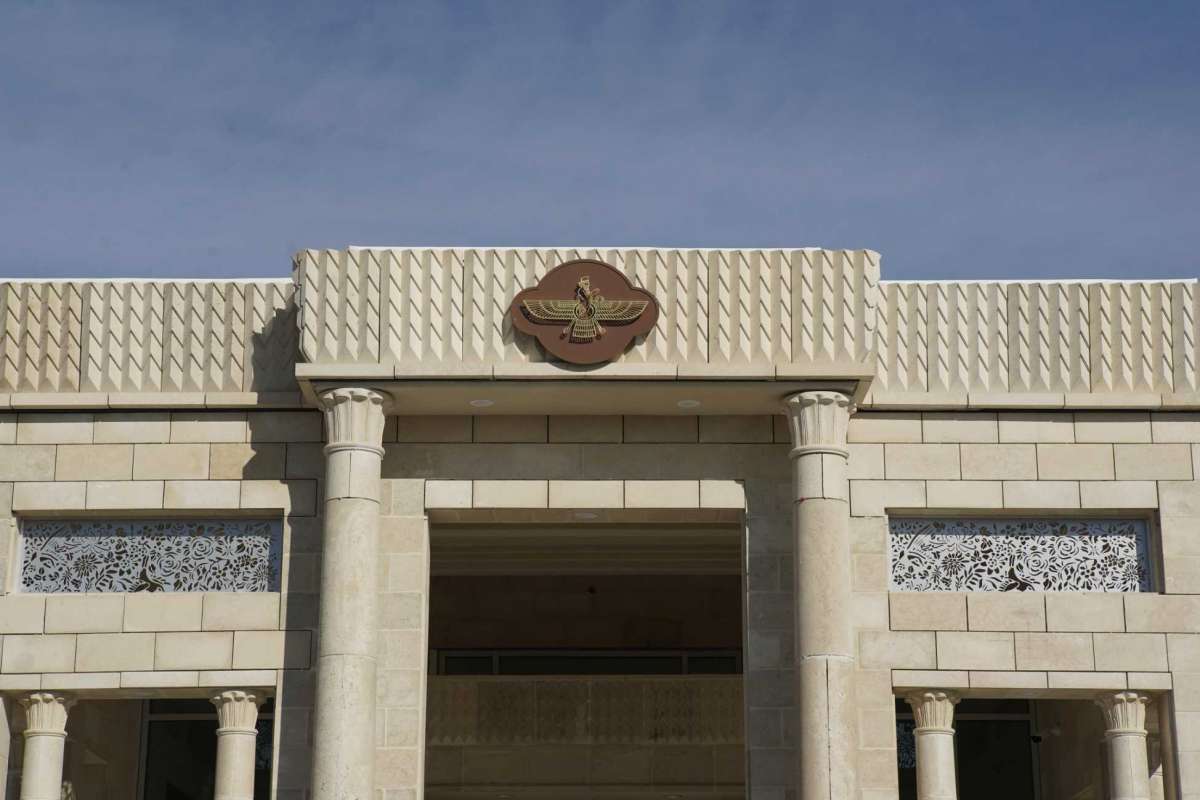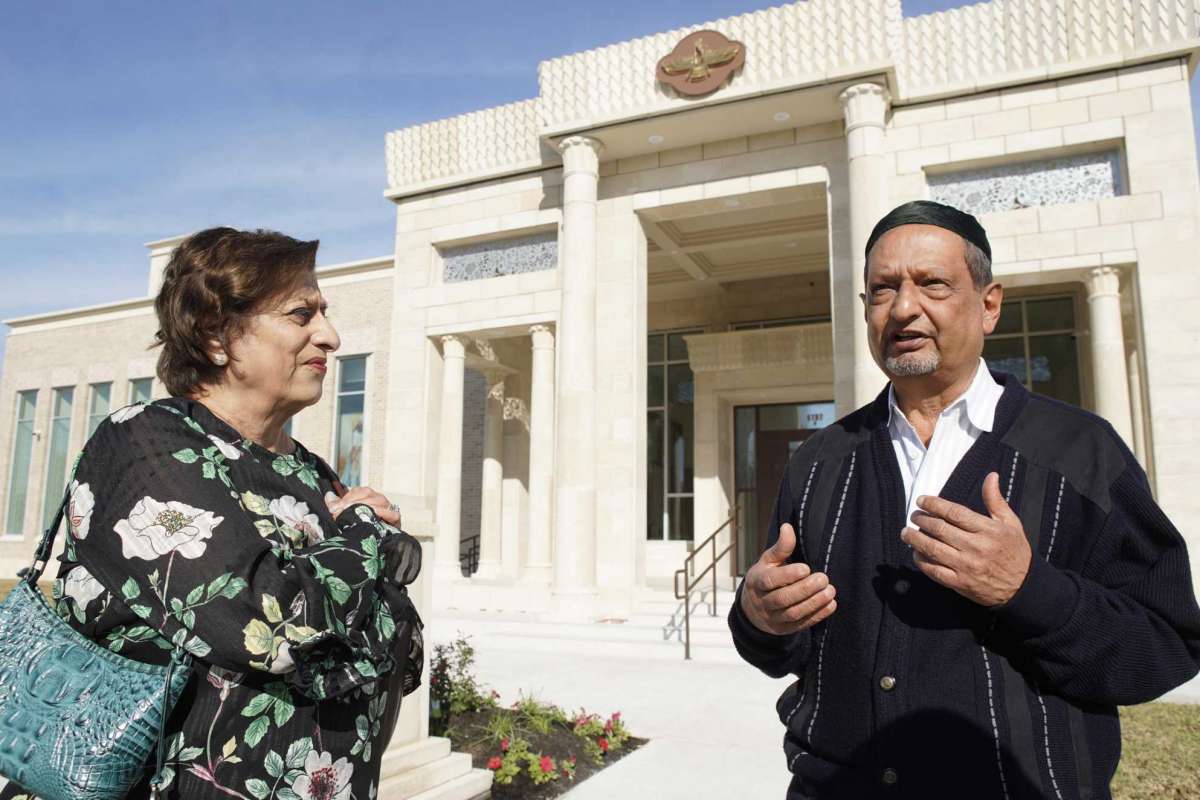On a typical-looking stretch of southwest Houston — down the street from Kwik Kar Lube and Storage Choice, across from a privacy fence hiding cookie-cutter McMansions — a Zoroastrian fire temple opened last week: a brand-new, sparkling-white place where priests from one of the world’s oldest religions tend a holy flame.
By Lisa Gray, www.houstonchronicle.com
When fully consecrated — the process can take years — the Bhandara Atash Kadeh temple at 8787 Airport will be the first temple in North America able to offer all of Zoroastrianism’s highest rituals, including the boyhood ordination of its priests. It’s a potent sign of the ancient faith’s growing strength on this continent.
That strength is especially notable given that the number of Zoroastrians is plummeting worldwide. At Zoroastrianism’s peak, a few hundred years before the birth of Christ, it was the world’s dominant religion.
The central tenets of the monotheistic religion, founded in what is now Iran, revolve around the opposition between the faith’s supreme creator, Ahura Mazda, and the forces of evil. Zoroastrians believe fire represents God’s light.
Zoroastrians don’t meet for weekly sermons. But the Atash Kadeh includes a space for seasonal gatherings. Photo: Melissa Phillip, Houston Chronicle / Staff photographerPhoto by: Photo: Melissa Phillip, Houston Chronicle / Staff photographer
These days, only 190,000 Zoroastrians remain, and everyone agrees that their number is dropping fast. India, Zoroastrianism’s stronghold, was home to 115,000 Zoroastrians in the 1940s. Now, it has only 60,000.
Over the same few decades, though, the U.S. population has grown substantially. Waves of immigration from India, Pakistan and Iran have brought the number of Zoroastrians here from nearly zero to more than 15,000. Of those, about 1,000 live in the Houston area.
Dinyar Patel, a University of South Carolina professor of South Asian history, is himself a Zoroastrian. “The way the population is shifting,” he said, “in probably a few decades, there will be more Zoroastrians here in North America than in India.”
That’s not to say that there will be many Zoroastrians in North America. Across the globe, for the past few generations, Zoroastrians have had very low birth rates: It’s estimated in India that for every Zoroastrian born, four are dying. The faith’s highly educated practitioners tend to marry late and have few children.
They also tend to marry people outside their faith. Even for those so inclined, there simply aren’t that many Zoroastrians to choose from. And among many Zoroastrian groups, customs make it difficult or impossible for a non-Zoroastrian spouse to convert, or for the couple’s children to be fully a part of the faith.
This Houston temple, though, will be open. “We must adapt in America,” Feroze “Fred” Bhandara, the donor behind the Atash Kadeh, told the crowd at its opening ceremony. “Otherwise we risk losing our children to other faiths.”
The new temple at 8787 Airport Road. Photo: Melissa Phillip, Houston Chronicle / Staff photographerPhoto by: Photo: Melissa Phillip, Houston Chronicle / Staff photographer
His children’s happiness
“My children are approaching their 40s,” Bhandara, 66, said recently. “My No. 1 priority is their happiness.”
One of Bhandara’s sons, Zubin, married a non-Zoroastrian, Eloisa, and their daughter Angela is very much on Bhandara’s mind. What his ancient religion needs, he believes, is more American-style openness and tolerance.
Like many Zoroastrian immigrants, Bhandara and his family have thrived in the U.S. He was born in Lahore, Pakistan, to a Parsi family whose successful brewing business seemed likely to run afoul of an increasingly conservative Muslim government. He came to the U.S. to study engineering, worked as an aerospace engineer in Palo Alto, Calif., and invested in real estate on the side.
In the 1980s, while in Houston to visit his sister, novelist Bapsi Sidhwa, he realized that the oil bust had made the city’s real estate an enormous bargain. He began shifting his investments, and in 1992, he and his family moved here full time.
They joined a growing Zoroastrian community. In 1975, when the Zoroastrian Association of Houston formed, it had only 15 members, but that number soon exploded, as immigrants from India, Pakistan and Iran settled here. Soon after Bhandara arrived, the association had amassed enough people and money to build a meeting hall with a small prayer room. Particularly for the Indian and Pakistani Zoroastrians, called Parsis, it was a place to socialize — a place to speak Gujarati and eat the foods they remembered from childhood.
They soon expanded the building to include Sunday school rooms. That was an accommodation to the U.S.: Zoroastrians don’t traditionally gather on Sundays. They worship chiefly at home, gathering only for feasts a handful of times a year. But the immigrant parents wanted their children — who spoke no Gujarati and whose friends were U.S.-born — to get at least a weekly dose of their culture.
They worried that their culture, and in particular, their religion, might disappear. The U.S. Zoroastrian population has grown chiefly through immigration. As in India, Zoroastrians gravitate toward higher education and professional careers, with most putting off marriage and childbearing until later in life, and so having few children. “One wonders, in two to three generations, how many will still practice the faith,” Patel, the USC professor, said glumly.
Iranian Zoroastrians are generally open to converts, but in India, orthodox believers frown on them and outright prohibit them from participating in services. Bhandara has seen non-Zoroastrian spouses and children with only one Zoroastrian parent treated rudely at cultural gatherings.
Aban Rustomji, the unofficial historian of Houston Zoroastrians, admires an Iranian display for Nowruz, the holiday that celebrates the spring equinox. Photo: Melissa Phillip, Houston Chronicle / Staff photographerPhoto by: Photo: Melissa Phillip, Houston Chronicle / Staff photographer
Five years ago, the real-estate developer began thinking about donating money to build a proper fire temple in Houston. He wanted a temple where his granddaughter and her mother would feel embraced by their community. He felt that a majority of Houston’s Zoroastrians would side with him. But he also knew that a minority would be strongly opposed.
Fearing rejection, he anonymously offered full funding — he won’t say how much — to build a temple that would be open to anyone who wanted to come in, would welcome converts and might serve as a magnet to draw young Zoroastrian families to Houston.
In secret, he prepared a PowerPoint presentation laying out the case for a temple that would be open to everyone, American-style, and let people believe that the anonymous proposal came from overseas, maybe from Hong Kong. After it was presented, he waited nervously for the association’s vote.
Eighty-seven percent voted to accept.
‘Fire catches people’s imagination’
On a recent Friday morning, after staying up all night for the temple’s opening rites, Bhandara removed his shoes, then showed a couple of non-Zoroastrian visitors the ritual areas where men and women would wash their hands and faces, purifying themselves before they draw nearer to the fire.
“It’s a living faith, an agrarian faith — about nature, water, soil,” he explained. Like other temples, this one includes an outdoor fountain, but it’s not called a water temple. “Fire catches people’s imagination.”
Aban Rustomji, the association’s unofficial historian, noted that in practice, Zoroastrianism boils down to three things: “good words, good thoughts, good deeds. So simple, so hard to adhere to.”
Looking around proudly, she pointed out how serene the temple felt, simultaneously modern and traditional. Chicago architect Cyrus Rivetna, she noted, studied ancient fire temples in India and Iran before designing it.
“I have a son who’s married to a non-Zoroastrian,” Fred Bhandara, left, asked priest Zerkxis Bhandara. “How do we get together as a family to meet our spiritual needs?” Photo: Melissa Phillip, Houston Chronicle / Staff photographerPhoto by: Photo: Melissa Phillip, Houston Chronicle / Staff photographer
A young priest visiting from California tended one of the prayed-over, purified fires. Zerkxis Bhandara — no relation to Feroze — prodded a log that was burning in what looked like a giant silver trophy cup.
Zerkxis, 24, is, as is customary for Zoroastrian priests, a son from a priestly family. When he was a kid in Orange County, Calif., older Zoroastrians would look at him hopefully and say things like, “You’ll be next.” Still, when he was 11, his father, the most active priest in Southern California, offered him a choice: Did he want to be ordained?
Zerkxis did. Ordination required trips to India. He traveled with family members and two other boys his age who aimed to be ordained. There were two sets of 10-day ordination rituals, each of which included nine days of isolation from the world in a room at a temple. So that he’d have no contact with the world, he wore gloves, but really, he says, the isolation wasn’t severe: He was allowed to talk with family members. And during the first round, at the more relaxed of the two temples, his gloved friends even played Gameboys.
Zerkxis wasn’t a Gameboy kid. In him, there’s a streak of longing for the old Parsi ways. He’s the rare second-generation American who speaks Gujarati, and in college, he majored in religious studies. For his thesis, wrote an ethnography about Zoroastrian practices in the U.S. He’s currently applying to graduate schools in anthropology, where, ideally, he’d be able to study Zoroastrians again.
At the Houston fire temple, Zerkxis accompanied Bhandara, Rustomji and the visitors to the seclusion rooms where someday young priests could stay as they seek ordination.
Everyone agrees that ordaining American priests would be a big deal. Arda Minocherhomjee, president of the North American Mobeds Council, said that though his own young sons went to India to be ordained, he’s not sure that his grandchildren will. For the generations who don’t speak Gujarati, it’s an intimidating trip. Houston would be far easier.
Zerkxis, though, wasn’t as sure that initiating priests here would be a good idea. To his way of thinking, India is where the orthodoxy lies. Faced with a difficult question, he asks himself, what would they do in India?
Suddenly, outside the isolation rooms, Bhandara turned to him with one such difficult question — testing him, maybe, or showing the non-Zoroastrians how the conservative wing of the faith thinks. “I have a son who’s married to a non-Zoroastrian,” Bhandara said. “How do we get together as a family to meet our spiritual needs?”
“That depends,” Zerkxis replied, unrattled. “Do you pray at home daily?”
Bhandara said that wasn’t what he meant — that he wants his daughter-in-law and granddaughter to feel fully a part of the Zoroastrian community, both here at the temple and at the community center across the parking lot.
“I’m orthodox,” Zerkxis said flatly — politely but pointedly not giving Bhandara the answer he wanted. No conversions: That’s what the priests in India would say.
For a long couple of seconds, the conservative young priest and the progressive old philanthropist looked at each other without saying a word. Then Bhandara shrugged and continued leading the tour.
This sparkling white temple, and its policy of openness, was his argument, the best he could do to see that his faith survives.

